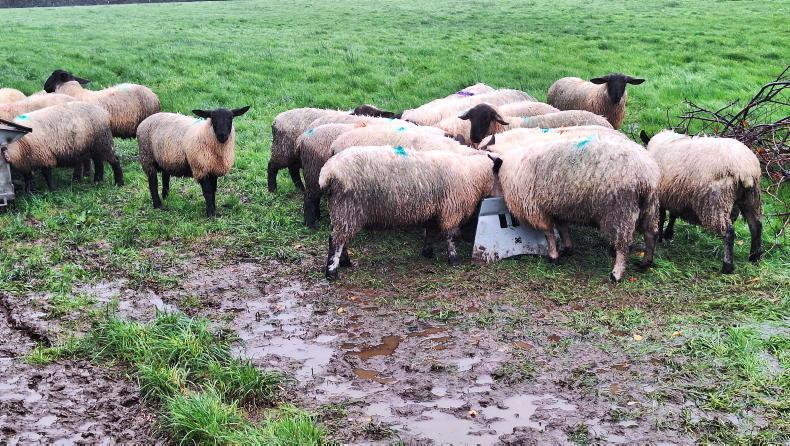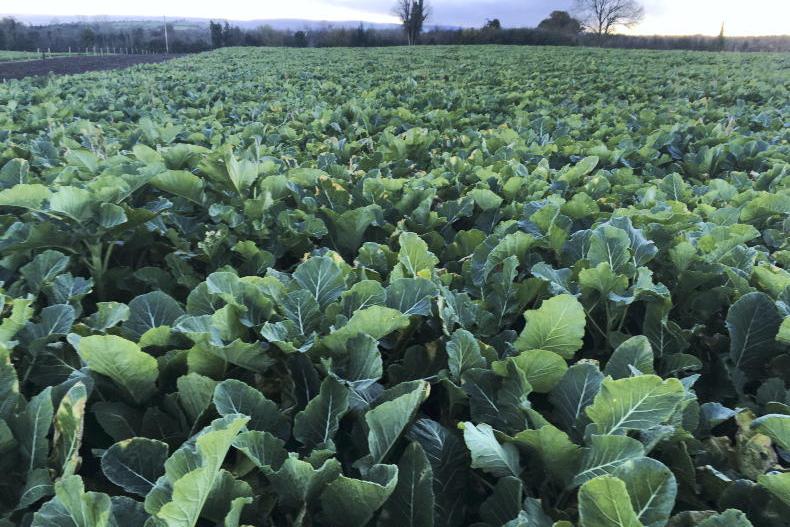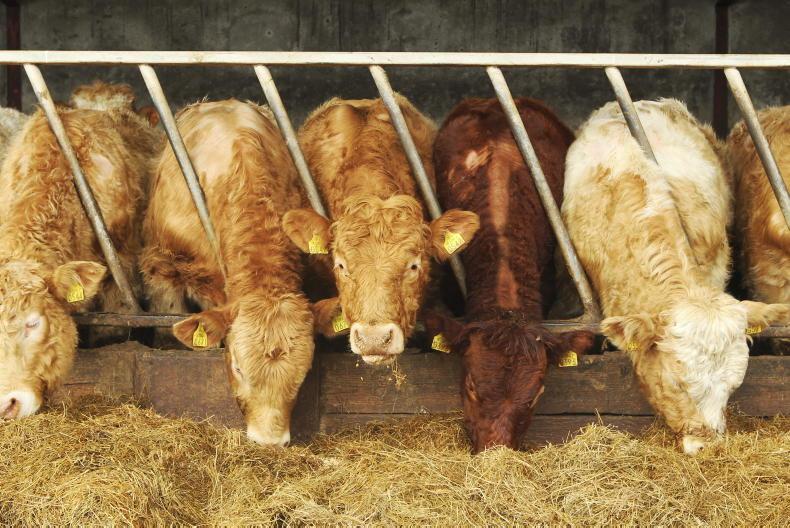There has been growing interest in recent years in the role of forage crops in lamb finishing systems. A study which commenced in 2019 in Teagasc Mellows Campus Athenry is generating valuable information on optimum grazing strategies, lamb selection and greenhouse gas emissions.
The trial, which is headed up by researcher Frank Campion and managed day-to-day by PhD student Mark Dolan, has two main objectives – examine the performance of hill and crossbred hill lambs when grazed on a selection of forages, and to quantify the difference in crop yield potential and carrying capacity when utilised in-store lamb finishing systems.

Lambs grazing forage crops had a lower methane output than lambs grazing on the grass treatments. \ Teagasc Athenry
Trial metrics
There are six treatments under scrutiny, including three forage crops – kale, forage rape and hybrid brassica; two grassland treatments (reseeded and permeant pasture) and an ad-lib concentrate diet. There are 75 lambs grazing in each treatment – 25 Scottish Blackface ram lambs, 25 Scottish Blackface wether lambs and 25 Texel x Scottish Blackface-cross ram lambs.
Land has typically been ploughed and power-harrowed in April, with a stale seedbed generated for forage rape and hybrid brassica. Kale was sown in late May/early June, the grass reseed was sown in mid-June, while the other two forages were sown in late June.
The data presented in this article is analysis for the last three seasons. Data and forage sample collection and analysis is ongoing for 2023. A quick overview of data collected since October 2023, shows there is likely to be no major variation to what is presented in this article, with findings broadly in line with those from recent years.

Lamb performance on permanent pasture was the lowest of all six treatments. There is a role for grass to bring lambs to heavier weights, but finishing on grass alone is challenging. \ Teagasc Athenry
Trial results
Starting with crop yield potential and carrying capacity, this first shows that kale achieved the highest yield. However, as demonstrated in Figure 1, the crop only recorded 3.8t utilisable yield, or just 53% of total forage available. Forage rape is not far behind kale for overall production and with a higher level of utilisation (58%), it achieved an utilisable yield of 4t. The hybrid brassica recorded the highest utilisation of 62%. This compensated for a lower production figure, leaving the crop matching the utilisable yield of forage rape.
Figures 2 and 3 explain why the utilisation rate was so low in kale. The crop grew fast, but was made up of 65% stem. This compares to just 45% for hybrid brassica and 47% for forage rape. Frank explains that the strong and thick nature of the kale stem is not ideally suited to sheep and is better suited to grazing with bovines. The utilisation figure could be improved by forcing lambs to eat more of the stem, but this would negatively affect performance.
The low utilisation of stem in forage rape is likely due to a lighter stem being trampled, but the crop achieved the highest leaf utilisation figure of 84%.

The study hopes to investigate nitrate leaching and look at water quality metrics in the future.
Lamb performance
Figure 4 demonstrates lamb performance across the six treatments. Hybrid brassica achieved the highest performance of the forages (132g/day), followed by forage rape (130g) and kale (127g). Performance of 150g to 250g/day has been recorded during dry periods and once lambs have become accustomed to the crop.
The performance on forage crops was significantly ahead of reseeded pasture (74g) and permanent pasture (38g), while, as expected, the highest performance was achieved by lambs on the intensive concentrate treatment. Unsurprisingly, Texel x Scottish Blackface lambs performed 16% to 20% higher than Scottish Blackface lambs on the three forage crops and ad-lib meal and up to 40% higher on the grass treatments.
Table 1 details the percentage of lambs drafted for slaughter from forage crops. As is quickly evident, light lambs have a low chance of reaching slaughter weight, while it is pretty clear that an early sown kale crop is inferior to the other two forages in terms of lamb performance.
Slaughter performance
Lambs on the all concentrate diet were 4kg heavier at slaughter, with lambs on the three forage crops similar at approximately 43kg liveweight. There was no difference in kill-out percentage of 45.3% to 45.4% for lambs finished on ad-lib meal, forage rape and kale, while lambs finished on hybrid brassica achieved a slightly lower kill-out of 44%.
Methane production
Some early analysis has been completed on methane production of lambs, while on the different treatments and the results are detailed in Figure 5. The data was collected using PACs (Poratble Accumulation Chambers), which allows the methane produced from the different treatments to be ranked against each other. Lambs grazing on the three forage crops during the winter produced significantly less methane than the grass treatments, with kale highest of the forage crops.
There has been growing interest in recent years in the role of forage crops in lamb finishing systems. A study which commenced in 2019 in Teagasc Mellows Campus Athenry is generating valuable information on optimum grazing strategies, lamb selection and greenhouse gas emissions.
The trial, which is headed up by researcher Frank Campion and managed day-to-day by PhD student Mark Dolan, has two main objectives – examine the performance of hill and crossbred hill lambs when grazed on a selection of forages, and to quantify the difference in crop yield potential and carrying capacity when utilised in-store lamb finishing systems.

Lambs grazing forage crops had a lower methane output than lambs grazing on the grass treatments. \ Teagasc Athenry
Trial metrics
There are six treatments under scrutiny, including three forage crops – kale, forage rape and hybrid brassica; two grassland treatments (reseeded and permeant pasture) and an ad-lib concentrate diet. There are 75 lambs grazing in each treatment – 25 Scottish Blackface ram lambs, 25 Scottish Blackface wether lambs and 25 Texel x Scottish Blackface-cross ram lambs.
Land has typically been ploughed and power-harrowed in April, with a stale seedbed generated for forage rape and hybrid brassica. Kale was sown in late May/early June, the grass reseed was sown in mid-June, while the other two forages were sown in late June.
The data presented in this article is analysis for the last three seasons. Data and forage sample collection and analysis is ongoing for 2023. A quick overview of data collected since October 2023, shows there is likely to be no major variation to what is presented in this article, with findings broadly in line with those from recent years.

Lamb performance on permanent pasture was the lowest of all six treatments. There is a role for grass to bring lambs to heavier weights, but finishing on grass alone is challenging. \ Teagasc Athenry
Trial results
Starting with crop yield potential and carrying capacity, this first shows that kale achieved the highest yield. However, as demonstrated in Figure 1, the crop only recorded 3.8t utilisable yield, or just 53% of total forage available. Forage rape is not far behind kale for overall production and with a higher level of utilisation (58%), it achieved an utilisable yield of 4t. The hybrid brassica recorded the highest utilisation of 62%. This compensated for a lower production figure, leaving the crop matching the utilisable yield of forage rape.
Figures 2 and 3 explain why the utilisation rate was so low in kale. The crop grew fast, but was made up of 65% stem. This compares to just 45% for hybrid brassica and 47% for forage rape. Frank explains that the strong and thick nature of the kale stem is not ideally suited to sheep and is better suited to grazing with bovines. The utilisation figure could be improved by forcing lambs to eat more of the stem, but this would negatively affect performance.
The low utilisation of stem in forage rape is likely due to a lighter stem being trampled, but the crop achieved the highest leaf utilisation figure of 84%.

The study hopes to investigate nitrate leaching and look at water quality metrics in the future.
Lamb performance
Figure 4 demonstrates lamb performance across the six treatments. Hybrid brassica achieved the highest performance of the forages (132g/day), followed by forage rape (130g) and kale (127g). Performance of 150g to 250g/day has been recorded during dry periods and once lambs have become accustomed to the crop.
The performance on forage crops was significantly ahead of reseeded pasture (74g) and permanent pasture (38g), while, as expected, the highest performance was achieved by lambs on the intensive concentrate treatment. Unsurprisingly, Texel x Scottish Blackface lambs performed 16% to 20% higher than Scottish Blackface lambs on the three forage crops and ad-lib meal and up to 40% higher on the grass treatments.
Table 1 details the percentage of lambs drafted for slaughter from forage crops. As is quickly evident, light lambs have a low chance of reaching slaughter weight, while it is pretty clear that an early sown kale crop is inferior to the other two forages in terms of lamb performance.
Slaughter performance
Lambs on the all concentrate diet were 4kg heavier at slaughter, with lambs on the three forage crops similar at approximately 43kg liveweight. There was no difference in kill-out percentage of 45.3% to 45.4% for lambs finished on ad-lib meal, forage rape and kale, while lambs finished on hybrid brassica achieved a slightly lower kill-out of 44%.
Methane production
Some early analysis has been completed on methane production of lambs, while on the different treatments and the results are detailed in Figure 5. The data was collected using PACs (Poratble Accumulation Chambers), which allows the methane produced from the different treatments to be ranked against each other. Lambs grazing on the three forage crops during the winter produced significantly less methane than the grass treatments, with kale highest of the forage crops.












SHARING OPTIONS